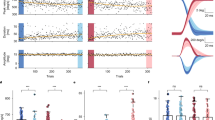Abstract
We extend the cerebellar learning model proposed by Kawato and Gomi (1992) to the case where a specific region of the cerebellum executes adaptive feed-back control as well as feedforward control. The model is still based on the feedback-error-learning scheme. The proposed adaptive feedback control model is developed in detail as a specific neural circuit model for three different regions of the cerebellum and the learning of the corresponding representative movements: (i) the flocculus and adaptive modification of the vestibulo-ocular reflex and optokinetic eye-movement responses, (ii) the vermis and adaptive posture control, and (iii) the intermediate zones of the hemisphere and adaptive control of locomotion. As a representative example, simultaneous adaptation of the vestibulo-ocular reflex and the optokinetic eye-movement response was successfully simulated while the Purkinje cells receive copies of motor commands through recurrent neural connections as well as vestibular and retinal-slip parallel-fiber inputs.
Similar content being viewed by others
References
Albus JS (1971) A theory of cerebellar functions. Math Biosci 10:25–61
Anastasio TJ (1991) Neural network models of velocity storage in the horizontal vestibulo-ocular reflex. Biol Cybern 64:187–196
Arnold DB, Robinson DA (1991) A learning network model of the neural integrator of the oculomotor system. Biol Cybern 64:447–454
Ezure K, Graf W (1984) A quantitative analysis of the spatial organization of the vestibulo-ocular reflexes in lateral-and frontaleyed animals — I. Orientation of semicircular canals and extraocular muscles. Neuroscience 12:85–93
Fujita M (1982a) Adaptive filter model of the cerebellum. Biol Cybern 45:195–206
Fujita M (1982b) Simulation of adaptive modification of the vestibulo-ocular reflex with an adaptive filter model of the cerebellum. Biol Cybern 45:207–214
Gellman R, Gibson AR, Houk JC (1985) Inferior olivary neurons in the awake cat: Detection of contact and passive body displacement. J Neurophysiol 54:40–60
Gerrits NM, Voogd J (1989) The topographical organization of climbing and mossy fiber afferents in the flocculus and the ventral paraflocculus in rabbit, cat and monkey. In: Strata P (eds) The olivocerebellar system in motor control. Experimental Brain Research Series, Vol 17. Springer, Berlin Heidelberg New York, pp 26–29
Gomi H, Kawato M (1990) Learning control for a closed loop system using feedback-error-learning. Proc IEEE Conf Dec Cont 3289-3294 (December, Hawaii)
Ito M (1970) Neurophysiological aspects of the cerebellar motor control system. Int J Neurol 7:162–176
Ito M (1984) The cerebellum and neural control. Raven Press, New York
Ito M (1989) Long-term depression. Annu Rev Neurosci 12:85–102
Ito M, Nagao S (1991) Comparative aspects of horizontal ocular reflexes and their cerebellar adaptive control in vertebrates. Comp Biochem Physiol 98c:221–228
Jeneskog T, Johansson H (1977) The rubro-bulbospinal path. A descending system known to influence dynamic fusimotor neurones and its interaction with distal cutaneous afferents in the control of flexor reflex afferent pathways. Exp Brain Res 27:161–179
Kawato M (1990) Computational schemes and neural network models for formation and control of multijoint arm trajectory. In: Miller T, Sutton R, Werbos P (eds) Neural networks for control. MIT Press, Cambridge MA, pp 197–228
Kawato M, Gomi H (1992) A computational model for four regions of the cerebellum based on feedback-error-learning. Biol Cybern
Kawato M, Furukawa K, Suzuki R (1987) A hierarchical neural-network model for control and learning of voluntary movement. Biol Cybern 57:169–185
Lisberger SG (1988) The neural basis for learning of simple motor skills. Science 242:728–735
Maekawa K, Simpson JI (1973) Climbing fiber responses evoked in vestibulocerebellum of rabbit from visual system. J Neurophysiol 36:649–666
Marr D (1969) A theory of cerebellar cortex. J Physiol 202:437–470
Matsukawa K, Udo M (1985) Responses of cerebellar Purkinje cells to mechanical perturbations during locomotion of decerebrate cats. Neurosci Res 2:393–398
Nagao S (1988) Behavior of floccular Purkinje cells correlated with adaptation of horizontal optokinetic eye movement response in pigmented rabbits. Exp Brain Res 73:489–497
Nagao S (1991) Contribution of oculomotor signals to the behavior of rabbit floccular Purkinje cells during reflex eye movements. Neurosci Res 12:169–184
Nagao S (1992) Different roles of flocculus and ventral paraflocculus for oculomotor control in the primate. NeuroRep 3:13–16
Nagao S, Ito M, Karachot L (1985) Eye field in the cerebellar flocculus of pigmented rabbits determined with local electrical stimulation. Neurosci Res 3:39–51
Nashner LM (1981) Analysis of stance posture in humans. In: Towe AL, Luschei ES (eds) Handbook of behavioral neurobiology, Vol 5. Plenum Press, New York, pp 527–565
Oscarsson O (1980) Functional organization of olivary projection to the cerebellar anterior lobe. In: Courvilee J, Montigny CD, Lamarre Y (eds) The inferior olivary nucleus. Anatomy and physiology. Raven Press, New York, pp 279–289
Robinson DA (1977) Linear addition of optokinetic and vestibular signals in the vestibular nucleus. Exp Brain Res 30:447–450
Simpson JI, Alley KE (1974) Visual climbing fiber input to rabbit vestibulocerebellum: a source of direction-specific information. Brain Res 82:302–308
Simpson JI, Graf W, Leonard CS (1989) Three-dimensional representation of retinal image movement by climbing fiber activity. In: Strata P (eds) The olivocerebellar system in motor control. Experimental Brain Research Series, Vol 17. Springer, Berlin Heidelberg New York, pp 321–337
Stone LS, Lisberger SG (1990) Visual responses of Purkinje cells in the cerebellar flocculus during smooth pursuit eye movements in monkeys. I. Simple spikes. J Neurophysiol 63:1241–1261
Udo M, Matsukawa K, Kamei H, Minoda K, Oda Y (1980) Cerebellar control of locomotion: effects of cooling cerebellar intermediate cortex in high decerebrate and awake walking cats. J Neurophysiol 44:119–133
Watanabe E (1985) Role of the primate flocculus in adaptation of the vestibulo-ocular reflex. Neurosci Res 3:20–38
Author information
Authors and Affiliations
Rights and permissions
About this article
Cite this article
Gomi, H., Kawato, M. Adaptive feedback control models of the vestibulocerebellum and spinocerebellum. Biol. Cybern. 68, 105–114 (1992). https://doi.org/10.1007/BF00201432
Received:
Accepted:
Issue Date:
DOI: https://doi.org/10.1007/BF00201432




